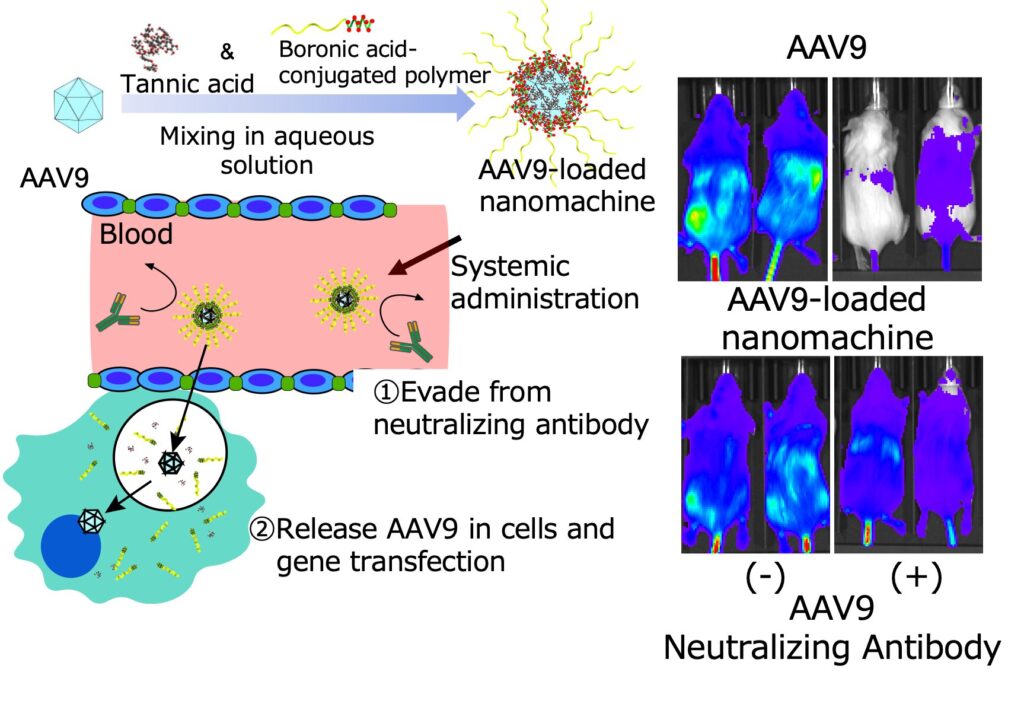Researchers have demonstrated, for the first time in the world using mice, the ability to overcome significant challenges in gene therapy using adeno-associated virus vectors (AAV), specifically “production of neutralizing antibodies” and “hepatotoxicity,” by employing a novel smart nanomachine equipped with AAV.
The research results are published in the journal ACS Nano.
The co-first authors of the paper are Assistant Professor Yuto Honda from the Laboratory for Chemistry and Life Science at the Institute of Science Tokyo. Dr. Hiroaki Kino, a Principal Research Scientist at iCONM, and Prof. Nishiyama are listed as corresponding authors alongside Prof. Honda, while other researchers from iCONM are acknowledged as co-authors.
The research team designed a nanomachine equipped with adeno-associated virus vectors (AAV) by combining tannic acid, a component found in wine and tea, with a precision-synthesized polymer made from phenylboronic acid. Using this approach, they successfully overcame the challenges of “reduced gene transfer efficiency due to neutralizing antibodies” and “hepatotoxicity resulting from accumulation in the liver” in mice for the first time in the world.
AAVs are clinically applied as gene therapy vectors, but it is known that patients with neutralizing antibodies against AAV do not achieve sufficient gene transfer efficiency, limiting the treatable patient population and the possibility of multiple administrations. The research team focused on the property of tannic acid, a natural component found in wine and other sources, to easily adhere to biomolecules.
By combining it with a precision-synthesized polymer made from phenylboronic acid, they developed a novel AAV-equipped nanomachine.
This AAV-equipped nanomachine demonstrated sufficient gene transfer activity even in the presence of AAV neutralizing antibodies and was also shown to suppress the increase of liver toxicity markers caused by AAV9 by inhibiting AAV accumulation in the liver.
Furthermore, this nanomachine exhibited gene transfer efficiency to the central nervous system comparable to that of AAV alone, indicating its potential for significant gene therapy effects.
The findings from this research are expected to be applied as a new therapeutic approach to viral vector treatments, which are currently limited by neutralizing antibodies.
To evade neutralizing antibodies from AAV, the research group developed an AAV-equipped nanomachine by combining tannic acid with precision-synthesized polymers.
Tannic acid, a type of polyphenol abundantly found in wine and tea, interacts with biomolecules such as proteins and viral vectors through hydrophobic interactions and hydrogen bonding, forming complexes. Additionally, tannic acid is a natural ingredient that has garnered attention as a material for pharmaceuticals due to its excellent biodegradability and biocompatibility.
Focusing on these outstanding properties of tannic acid, Honda and colleagues have previously reported on a biomolecule delivery nanomachine that combines tannic acid with a precision-synthesized polymer containing phenylboronic acid that forms esters with tannic acid.
This nanomachine can be easily formed by simply mixing the desired molecules with tannic acid and the precision-synthesized polymer in water, and it can release the loaded molecules at the acidic pH found inside cells, demonstrating sufficient activity.
The research group aimed to load AAV into this nanomachine to tackle the challenges in therapy (neutralizing antibodies, hepatotoxicity) without compromising the activity of the AAV. When AAV serotype 9 (AAV9) was systemically administered to mice with AAV neutralizing antibodies, the gene transfer efficiency in the brain and liver decreased to 5–15%.
However, by loading AAV9 into the nanomachine, the gene transfer efficiency in the brain and liver upon systemic administration increased to approximately 50–60%, significantly reducing the loss of activity compared to AAV9 alone. Furthermore, this nanomachine successfully limited the impact on the liver to below 10%, effectively suppressing the hepatotoxicity associated with high-dose AAV9 administration.
In this way, the nanomachine not only overcomes the challenges of gene therapy viruses but also demonstrates gene transfer efficiency in the brain comparable to that of AAV9 alone, addressing the issues posed by conventional delivery carriers that reduce AAV activity, and thus substantial gene therapy effects are expected.
Additionally, by combining microbubbles with focused ultrasound irradiation, the research successfully enhanced the selectivity of gene transfer to the brain by six-fold.
Provided by
Innovation Center of NanoMedicine


